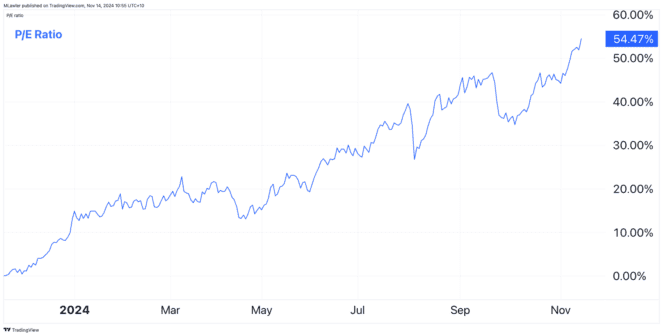The Commonwealth Bank of Australia (ASX: CBA) share price has embarked on yet another record-setting day.
At midday, Australia's most valuable bank fetched $152.18 per share. However, investors pushed the black and yellow bank to a new all-time high of $152.47 earlier in the session.
The sustained push higher means CBA shares now boast a 12-month gain of 49%—pulverising the 17.5% achieved by the S&P/ASX 200 Index (ASX: XJO). Yet, all of the increased valuation is attributable to investors' willingness to pay a greater premium for the banking giant.

As shown in the chart above, CBA's price-to-earnings (P/E) ratio has inflated by 54.5% in the past year. Meanwhile, cash net profits for the financial year have actually declined 2% to $9.84 billion. That's right — investors are paying more for less when it comes to the CBA share price.
Running onto the global stage
The series of record-shattering days for Commonwealth Bank suggests many aren't too bothered by the valuation.
Yesterday, CBA revealed a $2.5 billion profit for the first quarter, which aligned with expectations. Additionally, the bank's customer credit quality showed little sign of deterioration, and home loan arrears remained under control.
All in all, the bank appears stable. Some might even say predictable.
At a time when the future looks hazy in many ways, predictability is a welcomed change of scenery.
The beauty of Commonwealth Bank, and other ASX bank shares like it, is its strong exposure to the Australian property market. While there are many uncertainties over the next decade, one point that is likely to persist is the country's housing shortage.
As such, the perceived safety in property lending growth could be enough for big money to flock into CBA shares.
Whatever the reason, CBA's record-keeping ranks it as the tenth most valuable bank in the world in terms of market capitalisation. With today's gain, the Aussie bank is roughly only $14 billion away from overtaking the Royal Bank of Canada for the ninth spot.
How does the CBA share price compare?
We often hear that shares in the Commonwealth Bank of Australia are expensive relative to its peers. But is it actually true if we look further afield than our own backyard?
Below is a table summarising the P/E ratios of the ten most valuable banks in the world.
| Bank | Market Capitalisation | P/E Ratio |
| JPMorgan Chase & Co | US$674.4 billion | 13.4 |
| Bank of America Corp | US$352.0 billion | 16.7 |
| Industrial and Commercial Bank of China | US$282.7 billion | 6.1 |
| Wells Fargo & Co | US$243.5 billion | 15.1 |
| Agricultural Bank of China | US$204.3 billion | 6.3 |
| China Construction Bank | US$179.9 billion | 6.0 |
| Goldman Sachs Group | US$186.5 billion | 17.4 |
| Bank of China | US$183.8 billion | 6.5 |
| Royal Bank of Canada | US$174.3 billion | 15.3 |
| Commonwealth Bank of Australia | US$164.9 billion | 26.8 |
As you can see above, the CBA share price trades on the highest earnings multiple of the most valuable banks worldwide.








